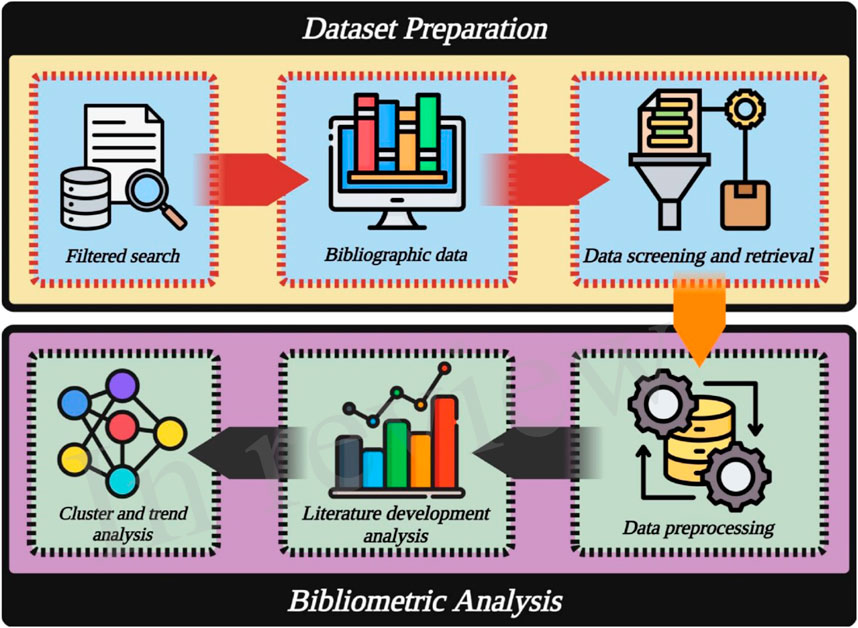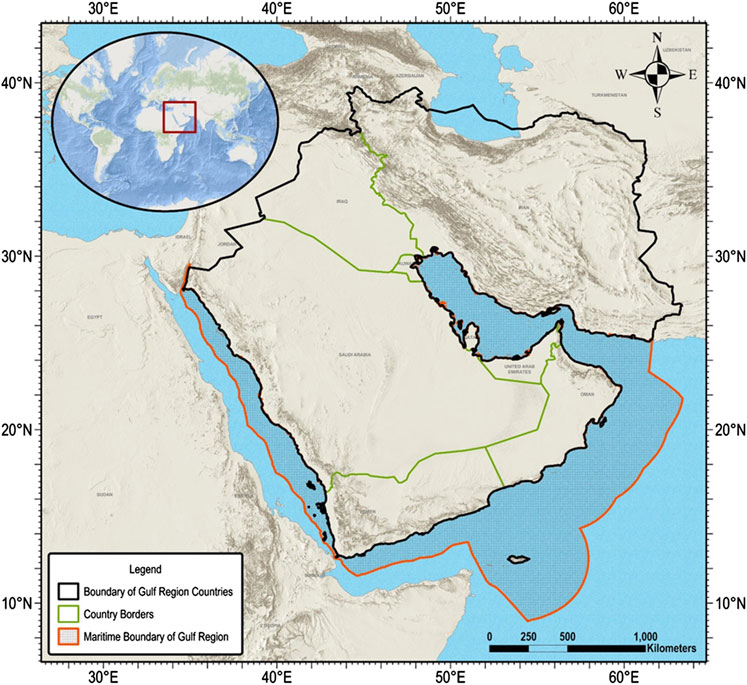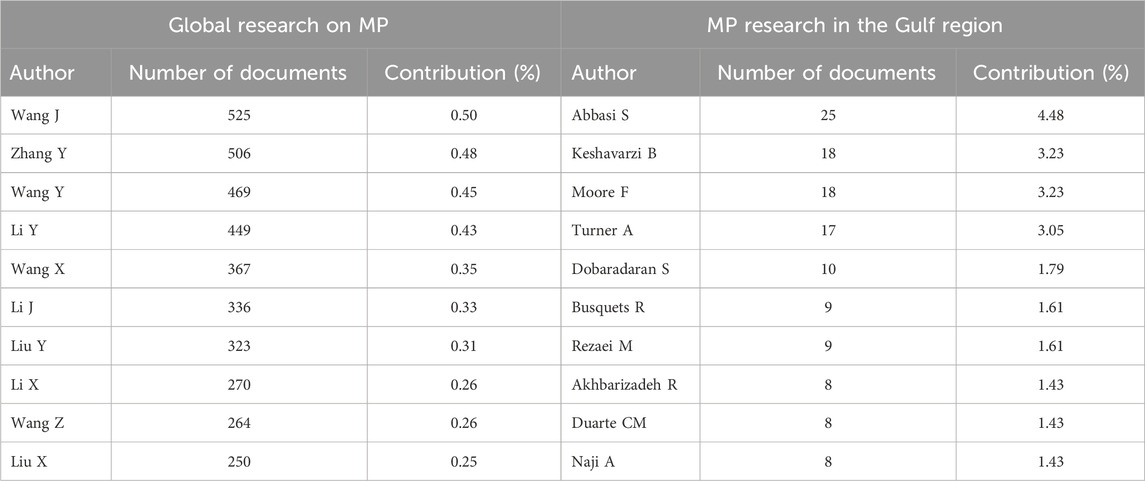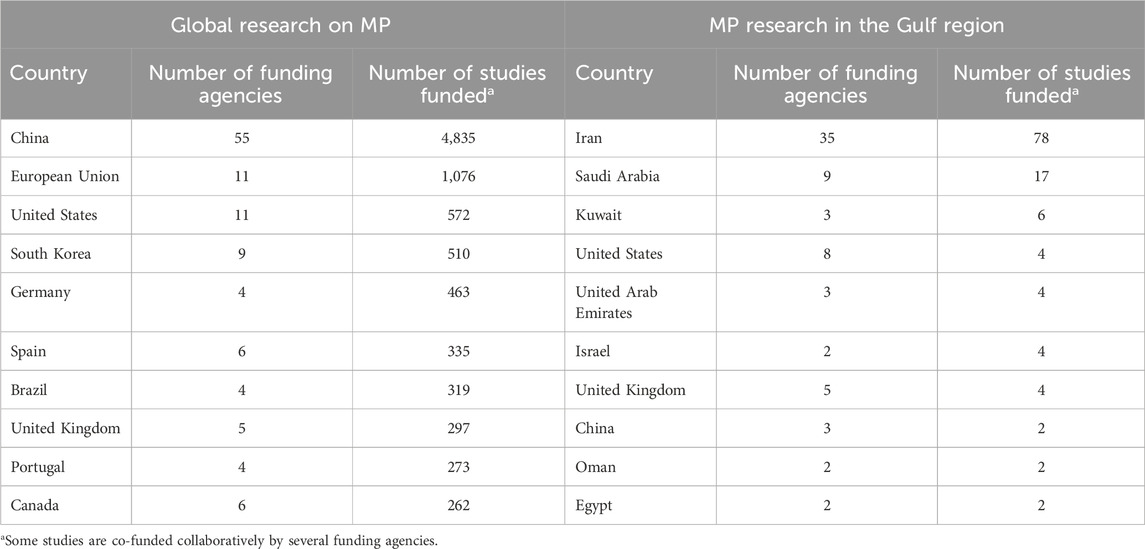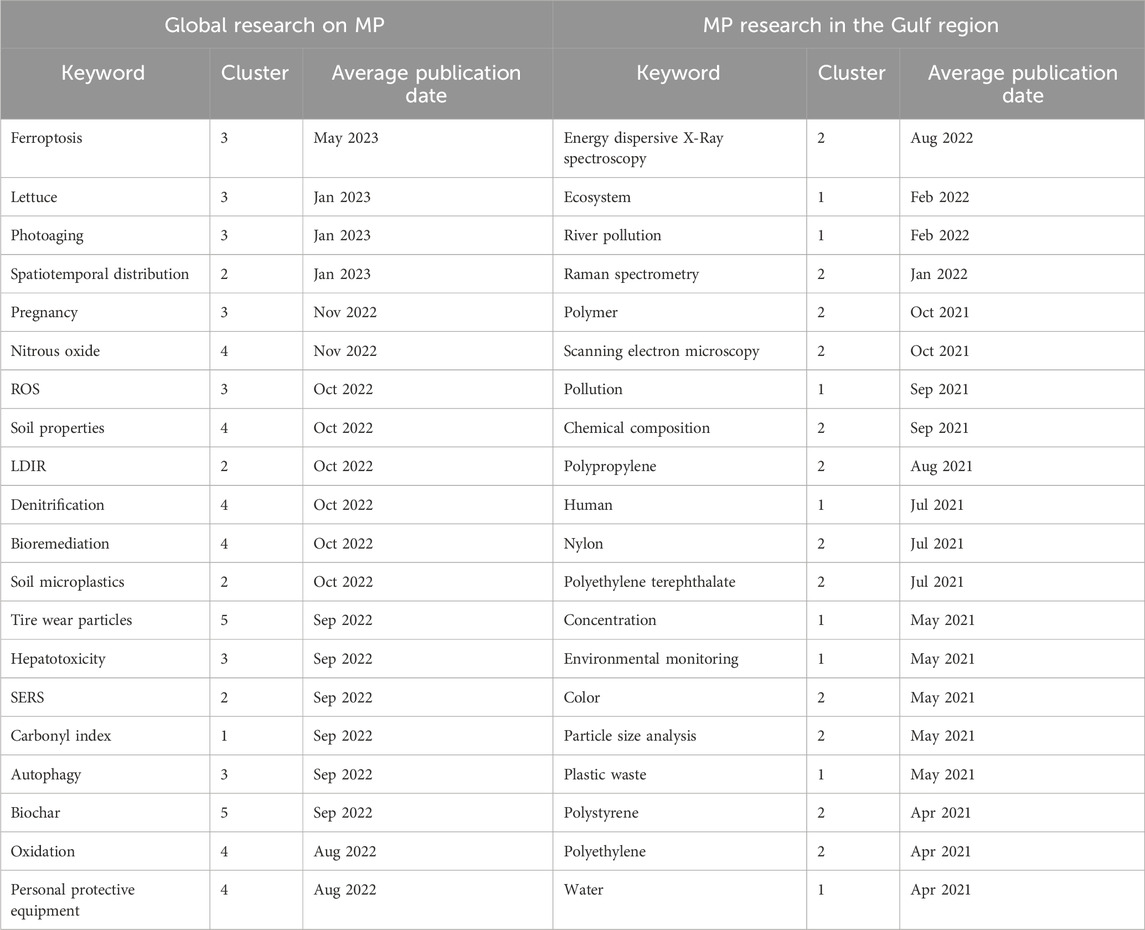- 1Department of Civil and Environmental Engineering, United Arab Emirates University, Al Ain, United Arab Emirates
- 2Ecohydrology Research Group, Department of Earth and Environmental Sciences, University of Waterloo, Waterloo, ON, Canada
- 3National Water and Energy Center, United Arab Emirates University, Al Ain, United Arab Emirates
- 4Water Institute, University of Waterloo, Waterloo, ON, Canada
Introduction: Microplastic (MP) pollution research has experienced significant global growth, with an exponential increase in publications since 2015. Despite this surge, research focused on the Gulf region remains limited. This gap is particularly concerning given the Gulf's dense industrial activities and substantial waste production. This study provides the first bibliometric analysis of MP research globally and within the Gulf region, examining the current state and emerging trends while identifying specific topics for future studies.
Methods: A bibliometric analysis of peer-reviewed articles published between 2000 and 2024 was conducted for global and Gulf region research. Bibliometric analysis employed several tools to identify trends, keyword networks, and research gaps, with manual refinement of keywords to enhance accuracy. The study also analyzed leading countries and institutions contributing to MP research.
Results and Discussion: The analysis highlights significant global contributions, with China emerging as a leader in MP research globally and Iran playing a prominent role within the Gulf region. While global publications have increased exponentially since 2015, the Gulf region's research output remains underrepresented, accounting for only about 1.1% of global publications. This underscores the need for enhanced regional research to better integrate the Gulf into the global discourse on MPs. Keyword analysis reveals that certain areas of MP research remain unexplored in the Gulf region. The trend analysis shows an evolving focus globally, shifting from basic interactions of MPs with marine environments to more complex issues such as environmental health and ecosystem impacts. This progression indicates a maturing field that increasingly addresses the broader implications of MP pollution.
1 Introduction
Pervasive occurrence and detection of microplastics (MPs) in a vast array of environmental matrices has ignited a novel, serious environmental concern around which a tremendously growing body of research has been formed in recent years (Thompson et al., 2009; Cole et al., 2011; Li et al., 2018). Studies have mentioned earlier the potential of MPs being transported to even the most distant marine environments to pose a threat to the aquatic and human lives (Horton and Barnes, 2020), making MPs a hazard of large scale impact (Prata et al., 2019). The current state and prospects of plastic production and consumption further highlight the importance of addressing this issue with urgency. Due to the wide scale of non-point sources of MPs (He et al., 2022; Tan et al., 2022; Jiang et al., 2024), there is a need for a multidisciplinary, comprehensive understanding of the current state of MP pollution to carve out promising solutions to the problem at hand.
Although there have been numerous studies focusing on MP pollution in different types of matrices, the number of studies exclusively focused on gulf areas—particularly the region in Western Asia (commonly recognized as the Gulf region)—has not seen relatively equal attention. Due to their commonly dense areas of commercial and industrial activities such as shipping traffic, aquaculture, and petroleum activities, coastal tourism, urban runoff, and wastewater discharge, gulf areas are prone to intense loads of MP pollution, which makes them the ultimate downstream location that offers a great chance to understand the dynamics of MP pollution. Despite these motivations for further research, gulf areas remain underrepresented in MP research, which may root in the complex nature of pathways and interactions inherent in MP pollution in marine environments (Ivar do Sul and Costa, 2014). This underrepresentation may stem from factors such as the high unpredictability of environmental conditions (Alfaro-Núñez et al., 2021) and the inadequacy of sampling methods used in marine samplings (Razeghi et al., 2021). One of the main reasons for this is the relatively small size of the samples that are used and reported for representing the state of pollution in these comparatively large areas (Harris, 2020; Thushari and Senevirathna, 2020; Alfaro-Núñez et al., 2021).
This is particularly critical, specifically in the Gulf region due to rapid urbanization and population growth in coastal areas, as well as high plastic consumption. As reported by Stöfen-O′Brien et al. (2022), mismanaged plastic waste streams are a major source of MP pollution, especially in Gulf region surrounded by centers of population producing 1.33 million metric tons of plastic waste annually. All of the above-mentioned factors point out the need for comprehensive and coordinated research in the Gulf region in order to gain a better understanding of the present state of MP pollution.
Prior to taking any further steps to approach the question at hand empirically, it is essential to obtain a dependable understanding about the present literature and establish a picture of the current state of knowledge regarding MP pollution in the Gulf region. Conventional methods of achieving this task usually rely on widespread investigation of manually selected resources, which has a good chance of missing valuable information, hence yielding a partially skewed understanding. One of the most robust and accurate approaches to overcoming this is bibliometric analysis, which is a powerful tool to identify trends, patterns, the current state, and future directions of research on a particular subject (Ellegaard and Wallin, 2015). Using comprehensive scholarly literature databases, and through a complete investigation of connections between authors, researchers, countries, and keywords of publications, bibliometric analysis can reveal new information that cannot be unlocked through conventional exploration of publications.
This study aims to systematically explore the current state of research on MPs both globally and in the Gulf region, revealing the current research status and identifying gaps to be addressed by future studies. The primary aim of incorporating global data was to provide a comparative framework that highlights the relative scarcity and scope of research specifically within the Gulf region. Based on the outputs, different aspects are analyzed for both research topics, including publication outputs, citation patterns, network analyses of authors and institutions, as well as trend analyses of topics. This research is crucial for addressing the environmental risks posed by MPs to marine biodiversity and the safety of the seafood supply, as evidenced by MP ingestion in commercial fish species and potential bioaccumulation through marine food webs that directly impact both ecosystem health and seafood security. The main objectives of this study include identifying the significant research gap present in the Gulf region regarding MPs, as well as the difference in tracks between global focus and the Gulf region’s focus on MP research.
2 Materials and methods
2.1 Gulf region study area
The study area for the bibliometric analysis of MP research in the Gulf region encompasses a significant portion of Western Asia, specifically highlighted by the marine and coastal environments critical to understanding the regional impact of MPs pollution. This region, as shown in Figure 1, includes four main areas of Persian Gulf, Gulf of Oman, Gulf of Aden, and the Red Sea, along with the countries with maritime boundaries in this region: the Kingdom of Saudi Arabia (KSA), Kuwait, Bahrain, Qatar, the United Arab Emirates (UAE), Oman, Iraq, Yemen, and Iran. These countries and water bodies constitute the broadest definition of the Gulf region, including countries of the Gulf Cooperation Council (GCC) and countries along the coastline of the Persian Gulf. This geographical scope is particularly relevant given the ecological, economic, and sociopolitical importance of these areas. It should be noted that countries on the western bank of the Red Sea, such as Egypt, Sudan, Eritrea, and Djibouti, were excluded from the analysis to maintain a more definitive scope of the Gulf region.
The Gulf region is a vital corridor for global oil shipping and possesses rich marine biodiversity that is highly susceptible to pollution exports from inland areas, including MPs (Samimi-Namin and Hoeksema, 2023). The region’s marine environment supports crucial economic activities that are particularly vulnerable to MP pollution. The fishing industry in the region faces direct threats from MPs through potential contamination of commercial species (Kibria, 2023). Moreover, the industrial sector in the Gulf region is heavily dependent on seawater for various processes, making it vulnerable to MP pollution. Desalination plants, which are pivotal in supplying freshwater needs in the region, include membrane water treatment technologies that concentrate MPs on the membrane and in the concentrate and their disposal channels MPs back to the environment (Tang and Hadibarata, 2021). Other marine-dependent industries, such as power generation facilities using seawater for cooling, petrochemical plants requiring process water, and coastal manufacturing units, are similarly affected by MP pollution through impacts on water intake systems and equipment deterioration. Therefore, focusing on the Gulf region for MP research addresses not only an environmental issue but also a critical economic concern affecting regional food security, industrial operations, and public health. The transboundary nature of MP pollution in these interconnected water bodies underscores the need for comprehensive regional studies and coordinated mitigation strategies.
2.2 Bibliometric analysis
Figure 2 depicts the flowchart summarizing the bibliometric analysis of MP research at both global and Gulf region scales. The bibliometric analysis framework summarizes the utilized databases, keywords, targeted publication period, exclusion criteria, filtering stages, total studies covered, and analysis tools. Two separate databases were obtained in the present study, one corresponding to the global scale analysis, while the other corresponding to the Gulf region. In the first step, for both frameworks, the articles of interest were searched for through SCOPUS and Google Scholar databases, to obtain the largest number of published papers that could relate to the present topic without applying any exclusion criterion. After obtaining the initial number of studies, conferences, book chapters, dissertations, notes, short surveys, editorials, articles in press, and non-English papers were excluded from the search results. The obtained articles were then analyzed using different software, such as VOSviewer, R-Studio (Bibliometrix), and Microsoft Excel, for trends, keywords analysis, research gaps, and different contributions.
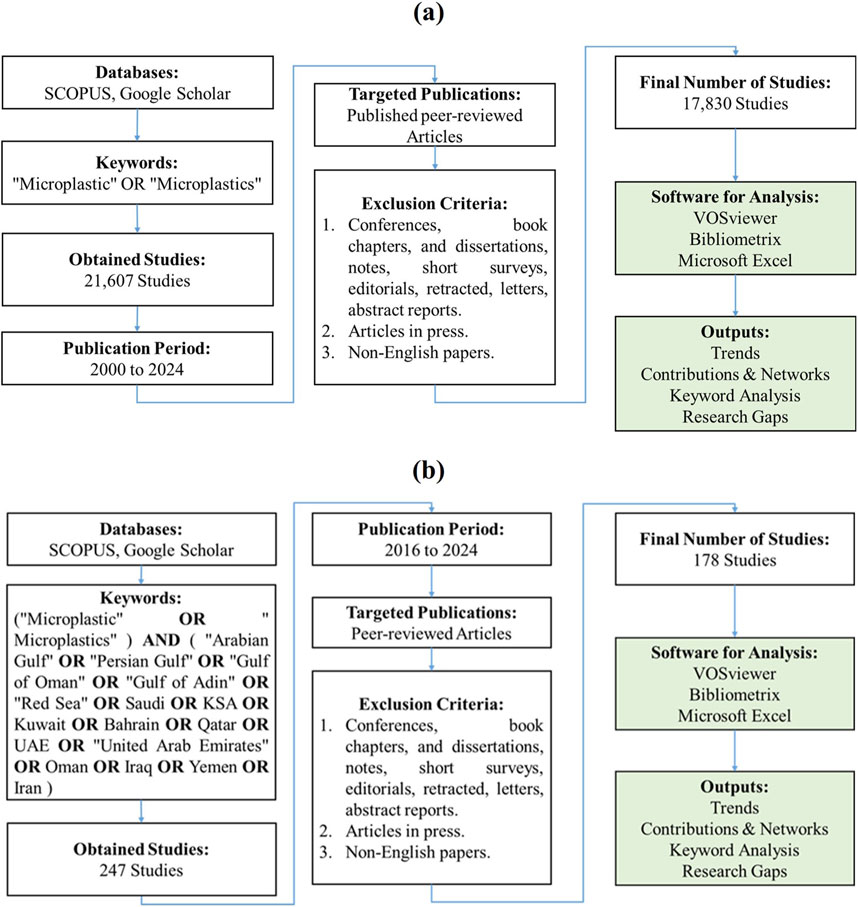
Figure 2. Bibliometric analysis framework of published articles on MPs globally (A) and in the Gulf region (B).
For the first step of bibliometric analysis related to global MP research (Figure 2A), the keywords used for searching the articles, mainly through the titles, keywords, and abstract, included the terms “Microplastic” OR “Microplastics”, to obtain an overview of globally conducted research regarding MPs, which returned 21,607 articles. Following, the filtering step was initiated, retaining only publications in the period of 2000–2024. Finally, after applying the exclusion criteria mentioned previously, the total number of studies was limited to 17,830 English, peer-reviewed journal studies. On the other hand, the keywords used for the second bibliometric analysis focusing on the Gulf region (Figure 2B) were included in the following search query: (“Microplastic” OR “Microplastics”) AND (“Arabian Gulf” OR “Persian Gulf” OR “Gulf of Oman” OR “Gulf of Aden” OR “Red Sea” OR Saudi OR KSA OR Kuwait OR Bahrain OR Qatar OR UAE OR “United Arab Emirates” OR Oman OR Iraq OR Yemen OR Iran). Initially, 247 studies were obtained, all published during the period of 2016–2024; hence, filtering of the publication period was not necessary, and the final number of studies obtained after applying other exclusion criteria was 178 studies.
The analysis of keywords network reveals smaller subjects within a certain topic, allowing for a detailed examination of research patterns and the topical structure of the larger subject at hand. VOSviewer is a powerful tool for this purpose, establishing the keyword network based on the co-occurrence of keywords in different studies. By analyzing the frequency of co-occurrence of two keywords in the literature, smaller topical zones that indicate the general focus of their representative articles can be identified. Identifying these smaller topical zones in MP research on both global and regional scales (e.g., the Gulf region) reveals relatively or completely untouched topics that have not been addressed by regional studies, thus providing invaluable suggestions for future research.
Before inputting the database into VOSviewer, several additional steps were conducted manually to ensure a more accurate depiction and analysis of the keyword network. As mentioned in previous sections, some fundamental keywords shared by almost all the extracted studies were used to obtain the data file for this analysis. Therefore, in the first manual step, these keywords were identified and omitted from the network analysis (Supplementary Table S1). Additionally, instances of differently phrased but synonymous keywords (e.g., “human” vs “humans” or “ocean pollution” vs “marine pollution”) were identified (Supplementary Table S2). Since VOSviewer uses the co-occurrence of keywords as the criterion for establishing connections and depicting the keyword network, it is essential to merge these similar keywords before conducting a meaningful analysis.
3 Results and discussion
3.1 Annual publications
The first output of the bibliometric analysis is the annual number of publications, which provides a quantitative comparison of research outputs between global and regional research conducted on MPs. Figure 3A shows the year-wise distribution of publications for global and Gulf region research. The global research on MPs, spanning 2000 to 2023 (2024 was excluded as it is not complete and the publications are up to July only), illustrated an overall significant increase in publication numbers. Initially, publication numbers were mostly in single digits until 2008, but a significant rise began in 2015, with the largest increases seen after 2018. The peak of this trend occurred in 2023 with 4,826 publications, highlighting a marked surge in global interest and research activity concerning MPs. In contrast, research on MPs specifically in the Gulf region, started in 2016 and showed a steady increase in publications, albeit at considerably lower levels. The regional research peaked at 47 publications in 2023, indicating a growing, yet more contained, research interest within the Gulf region.
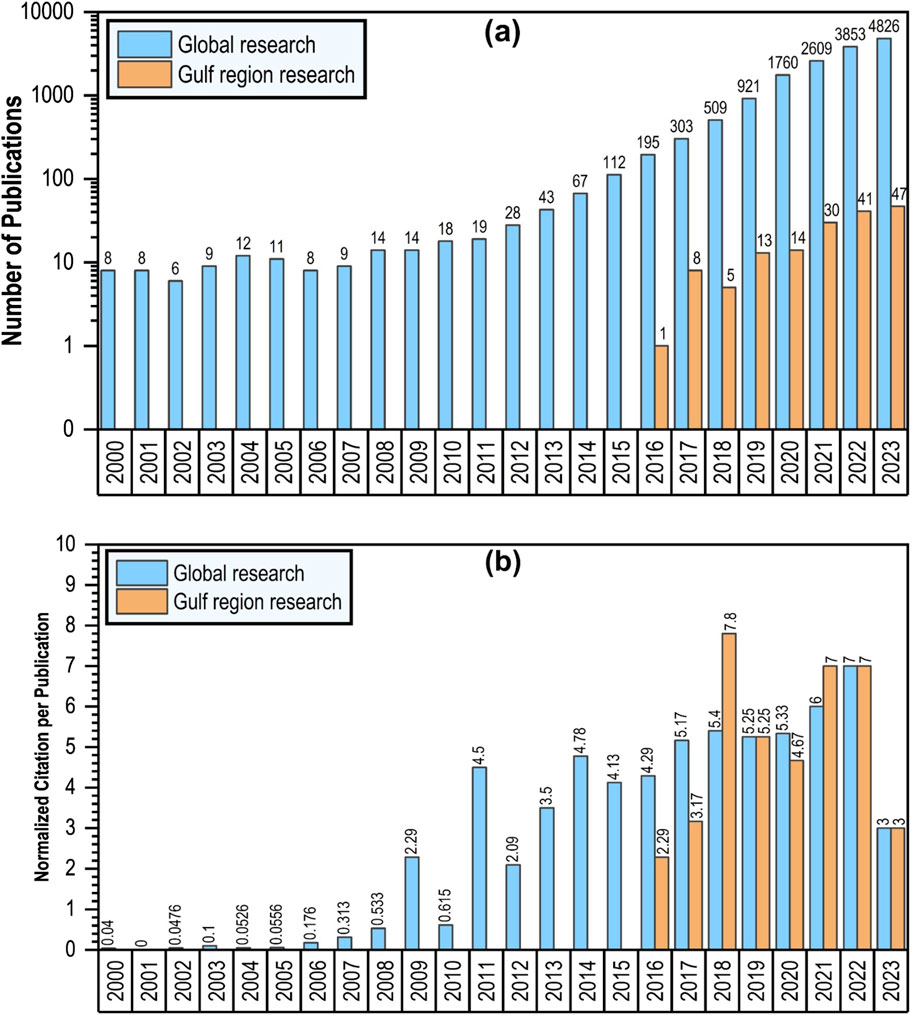
Figure 3. Year-wise distribution of publications on MPs globally and in the Gulf region since 2000 (A), and average annual citations for MPs research globally and in the Gulf region since 2000 (B).
The Gulf region’s research output, representing only 1.1% of global MP publications, appears disproportionately low given the region’s vulnerability to MP pollution. This relatively limited research contribution stands in contrast to other comparable marine regions, as evidenced by subsequent analysis of leading countries’ research outputs, suggesting potential opportunities for expanded research efforts in the Gulf. Both patterns demonstrate increasing trends, yet the global data reveals a more robust exponential growth. Interestingly, both scales witnessed their highest publication counts in 2023, indicating the increased interest in research regarding the topic. This comparative analysis highlights the escalating global and regional focus on MPs, showcasing varying scales of research engagement and intensities.
3.2 Average annual citations
Information regarding the influence of a publication on a scientific field can be obtained through citation pattern analysis. Furthermore, the development and growth structure within a field of research can be shown through the analysis of citation patterns (Bornmann and Daniel, 2008). Citation data and metrics derived from citations serve as a standard framework for comparing the relative effectiveness and impact of journals within a field of research. The average number of citations per year is calculated by dividing the total number of citations by the number of years the author or journal has been publishing papers. This can be a very useful metric to assess the yearly impact for a journal or author. However, since older publications have more time to receive recognition, it is essential to normalize citation scores to obtain an accurate picture. This normalization is achieved by dividing the total number of citations each publication has received by the number of years it has had to receive citations (up to 2023). Figure 3B shows variations in annual average citations per publication from 2000 to 2023 both globally and in the Gulf region. Globally, citations gradually increased until 2009, followed by a notable spike in 2011. This indicates that the work during these years was particularly impactful within the field. After 2011, yearly citations show a steady growth, suggesting sustained attraction towards the research topic at hand, peaking at 7 citations in 2022. In contrast, research on MPs in the Gulf region started in 2016, showing a swift ascent in citations, peaking sharply at 7.8 in 2018. This peak suggests that studies from this period were highly referenced, perhaps due to groundbreaking findings. From 2019, it is evident that Gulf region MP studies have received a similar level of recognition despite being at early stages of research development.
Comparatively, both patterns exhibit a peak in citations followed by a decline, reflecting a common lifecycle in academic citations where studies initially gain significant attention before stabilizing. The global research data shows a steadier increase and a longer peak, indicative of a gradual buildup of foundational research that has influenced subsequent studies over a more extended period. Conversely, MP research in the Gulf region displays a more sudden rise in number, which may indicate a rapid uptake and influence of global findings or focused impactful studies that sparked new research efforts.
3.3 Leading authors
Table 1 highlights the leading authors in publications related to MPs both globally and in the Gulf region. Globally, there are 38,506 authors with publications on MPs, which is a significantly huge number compared to the 558 authors that published on the same topic within the borders of the Gulf region. The leading global author on MPs, Wang J., accounts for only 0.5% (525 documents) of the total publications. In contrast, the leading author in research on MPs in the Gulf region, i.e., Abbasi S., contributes to around 4.5% (25 documents) of the total research publications. The average number of authors per publication provides useful insight into the level of collaboration across various studies. The average number of authors per publication on the global scale was 2.16; however, in the Gulf region, this value rises to 3.13, indicating a higher level of collaboration in the field of MP research.
3.4 Leading countries
Assessing the geographical distribution of publications in a research field provides critical insights into the global research landscape, revealing both regional focuses and international collaborations. This analysis not only highlights the leading contributors but also portrays the extent of intra- and inter-country collaborations that strengthen the development of related technologies. Table 2 outlines the leading 10 countries based on the number of publications according to Scopus database for both global and regional research conducted on MPs. It is evident that counties are not confined to collaborations within the same country, as all countries have multiple-country publications (MCPs), indicating collaboration between authors from different countries. In the global research landscape on MPs, China dominates with 5,735 documents, featuring a high level of international collaboration with 1,294 MCPs. This is followed by the United States and India, with substantial but considerably lower contributions. European nations such as Italy, Germany, and Spain also show strong involvement, particularly Italy, which demonstrates significant international collaboration. Other noteworthy contributors include South Korea, the United Kingdom, Australia, and Canada, all displaying robust research outputs and collaboration with other contributing countries. In contrast, research in the Gulf region is led by Iran, with 123 documents and 59 MCPs, followed by smaller contributions from the United Kingdom and Saudi Arabia. Other regional participants like Poland, the United States, Germany, the United Arab Emirates, Kuwait, Netherlands, and Egypt show varied levels of involvement and collaboration, with overall smaller research outputs compared to the global scene.
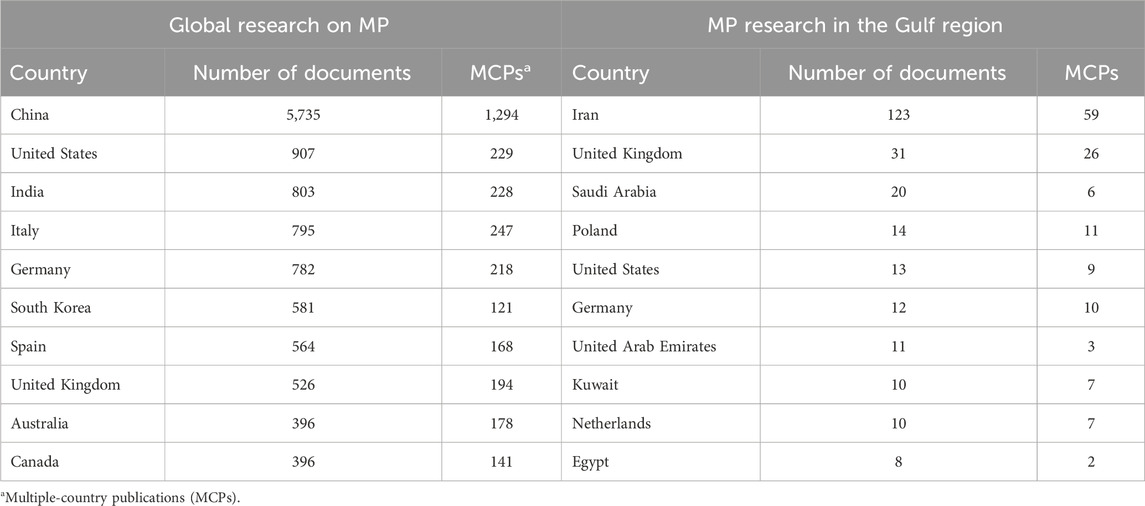
Table 2. The leading 10 countries according to the number of publications on MP research globally and in the Gulf region.
Based on Table 2, there is a clear disparity in the volume and scale of research activities. On the global scale, China is spearheading the MP research. Conversely, the Gulf region, led by Iran, presents a more modest but still collaborative research environment. The presence of countries outside of the Gulf region indicates international interest extending into MP research in the Gulf region. This highlights not only the different scales of research activities between the two areas but also the distinct focus and emerging significance of regional environmental research in the Gulf, contrasting with the extensive, established research networks seen globally.
The leading place of China in MP research could be explained by its significant industrial activities and associated pollution concerns, given its status as a major plastic producer and consumer. The extensive maritime boundaries of the country necessitate understanding the impact of MPs on marine ecosystems, crucial for maintaining the health of its fishing, shipping, and tourism industries. Moreover, leading MP research enhances geopolitical influence of this country, allowing it to shape international environmental policies. This aligns with the broader goals of demonstrating global leadership and advancing technological and scientific capabilities, particularly in developing new pollution control methods and recycling technologies.
In the Gulf region, the significant interest of Iran in research on MPs in the Gulf region originates from the need to protect the critical marine ecosystems of the Persian Gulf, which are vital for the fishing industry and overall economic growth of the country. This research is crucial for addressing the environmental risks posed by MPs to marine biodiversity and the safety of the seafood supply due to the impacts of MP ingestion on commercial fish species and potential bioaccumulation through marine food webs that would directly impact both ecosystem health and seafood security in the Gulf region (Kibria, 2023). The interest of the Gulf countries such as Iran and Saudi Arabia in researching MPs in the Gulf region reflects a shared regional concern, as the Persian Gulf’s marine ecosystems are crucial for local economies and biodiversity. Countries bordering the Persian Gulf account for approximately 50% of global desalination capacity (Ibrahim et al., 2020), which makes water quality of great importance to these countries. By leading studies in this area, Iran not only addresses public health concerns related to environmental pollutants but also positions itself as a regional leader in environmental studies.
3.5 Leading funding programs and agencies
3.5.1 Leading funding agencies on global MP research
Analysis of the performance of funding and sponsorship agencies is vital for a comprehensive investigation into a specific research topic. Studies funded through certain programs tend to be framed within a more strategic and meaningful framework, often necessitated by the funding agency. Additionally, financially supported studies are more likely to receive attention from the scientific community due to their generally higher quality, made possible by access to laboratory facilities and more rigorous sampling methods. Previous studies have shown a correlation between the average number of citations a paper receives and the amount of funding it has been granted (Wang and Shapira, 2011).
A deeper look into the programs providing funding support reveals the concerns driving these expenditures. Table 3 shows the performance of top countries in terms of funding global MP research, executed through smaller funding agencies, with the top 10 agencies shown in Supplementary Table S3. The results indicate that global MP research is predominantly funded through public programs. These funding agencies have collectively sponsored 66.5% of studies, while the rest have been conducted by independent researchers. According to Table 3, China has financially dominated the international stage through 55 public funding agencies that have supported 4,835 studies (30%) of global research on MPs and is responsible for 32% of global publications, highlighting the strong financial support behind Chinese institutions to drive global MP research. The European Union ranks second, with several developed countries collectively accounting for 6.6% of funding for MP research. The significant disparity in research outputs between China and other regions, such as the European Union and the United States, reflects not only the volume of funding but also the strategic prioritization of environmental research in these regions.
The substantial leadership of Chinese institutions is attributed to the serious water pollution challenges China has long battled through policies and regulations, such as “The Water Pollution Law,” “The Water Law,” “The Soil and Water Conservation Law,” and approximately eight other initiatives focusing on marine pollution, reflecting an extensive regulatory framework that began in 1988 with the “Marine Environment Protection Law of the People’s Republic of China (Marine Law).” This regulatory environment has galvanized Chinese institutions to prioritize MP research. Policies such as China’s “Marine Environment Protection Law” and the EU’s “Plastics Strategy” play a substantial role in aligning research priorities with national and regional environmental concerns (European Commission, 2019). While these policies provide a structured framework that may attract funding and support larger-scale research initiatives, the impact of these policies varies based on regional priorities and available resources. Previous studies indicate that China’s significant contributions to global plastic pollution mitigation are shaped by both international scrutiny and domestic necessity, with its legislative efforts bolstering research capabilities and regulatory effectiveness (Liu et al., 2022).
China’s regulatory framework has evolved from addressing single issues, such as banning plastic bags in 2007, to a comprehensive system targeting the entire plastic lifecycle. This includes policies focused on collection, recycling, and reuse, which have increasingly emphasized circular economy principles. Notably, China has implemented 122 policies that explicitly target MPs, reflecting the growing recognition of MPs as a critical environmental issue (Fürst and Feng, 2022). The 2017 national program for MP pollution research marked a significant milestone, further integrating MPs into broader regulatory and environmental protection strategies.
A detailed investigation into China’s funding mechanisms reveals that policy-driven initiatives often align with increased funding allocations, though further research could clarify the specific influence on study quality and research outcomes. The participation of various departments and institutions across provinces (e.g., Shandong, Jiangsu, Zhejiang, Guangdong, Fujian, Hainan, Shandong, Hubei, Hunan, Hebei, Heilongjiang, Guangxi, Jilin, and Jiangxi, respectively, in terms of the number of sponsored studies) along with national-level funding programs in the funding agency information confirms a collective national effort in MP research development. Analysis of the current state of MP research in China suggests that the regulatory environment will likely lead to even more restrictive policies on plastic waste and MP pollution in the future (Xu et al., 2021).
On the other hand, the commitment of the European Union to financially support MP research arises from its long-standing dedication to plastic pollution prevention and control on a regional level by aiming at plastic pollution directly or indirectly through programs such as “Plastics strategy,” “REACH (Registration, Evaluation, Authorization and Restriction of Chemicals) Regulation,” “Marine Strategy Framework Directive (MSFD),” “Horizon 2020 and Horizon Europe Programs,” “JPI Oceans MPs Projects (€18 million),” “Single-Use Plastics Directive,” and “Circular Economy Action Plan.” The collaborative funding approach within the European Union, fostering cross-border research initiatives, has significantly enriched the scientific literature on MPs. The unique success of this collective effort lies in the encouragement of different universities from various European countries to collaborate on their projects, which fertilizes literature enrichment through knowledge mobilization.
3.5.2 Leading funding agencies in gulf region
The sponsorship data on MP research in the Gulf region show that 74% of studies in the region are financially supported by various sponsorship programs. The Gulf region faces unique challenges in combating MP pollution due to its extensive coastline and high plastic usage, necessitating increased funding and coordinated research efforts to develop effective mitigation strategies. The financial resources required for conducting a conventional MP analysis study arise from significant costs associated with sampling, laboratory equipment, and personnel requirements. Meyers et al. (2024) estimated the costs of conducting seawater MP analysis to range from $850 for purely microscopy-based methods to $9,100 per year for more advanced spectroscopy methods, even with a sampling number as low as ten samples per year. Additionally, due to the relative novelty of the topic, the majority of scientific literature still demands more data collection to establish an adequate database before meaningful modeling efforts can reduce associated costs (Everaert et al., 2018; Koelmans et al., 2019; Lusher et al., 2021; Bäuerlein et al., 2023; Phan and Luscombe, 2023).
According to the number of funding agencies in the Gulf region, also shown in Table 3, Iranian institutes have been leading MP research in the region through 35 funding programs that have sponsored around 44% of studies on the subject. Notable projects funded by the Iran National Science Foundation have led to significant advancements in understanding MP pollution in the Persian Gulf, setting a benchmark for future research in the region. Saudi Arabia follows in second place, holding a 9.5% share of the research sponsorship. Although certain policies and action plans within the Gulf region countries focus on marine litter and, in particular, marine plastic pollution control, the majority of studies in the Gulf region are mainly funded by universities with a focus on broad research development rather than targeted environmental initiatives (Supplementary Table S4). For instance, Shiraz University alone has funded 18 studies, whereas no regionally coordinated environmental action plan appears in the sponsorship data. This distinction suggests a symptom of disconnect between the sources of research funding and the implementation of environmental policies, as the funding is predominantly allocated for academic research purposes, not directly tied to environmental action plans. This gap highlights the need for enhanced institutional support and better alignment between research efforts and environmental policies to harness the scientific findings from MP research in the Gulf region.
Globally, funding programs are incentivized through relevant environmental policies that provide financial resources to support studies addressing specific environmental issues. According to results of funding agencies’ activities, of the 17 countries that have sponsored MP pollution research in the Gulf region, only five (Iran, Saudi Arabia, Kuwait, United Arab Emirates, and Oman) are geographically located within the Gulf region. Countries outside the Gulf region sponsor around 19% of MP research in the Gulf region. A part of this external support comes through international programs such as the “G20 Implementation Framework for Actions on Marine Plastic Litter,” which are established within broader regional treaties. Considering the critical need for further research on MP pollution in the Gulf region, the necessity for increased financial support becomes even more evident. Future research efforts in the Gulf region should focus on comprehensive empirical studies enabled by improved financial contributions of the Gulf region countries and developing stronger policy frameworks to effectively address MP pollution.
3.6 Research keywords analysis
Figure 5 show the dynamic and complicated relationships among the keywords regarding global and regional MP research, respectively. The curved lines indicate the connections between keywords, highlighting their repetition in different studies. The size of the circles for each keyword in the co-occurrence network visualization generally signifies the frequency of occurrence of that keyword in the dataset. Larger circles represent keywords that appear more often in the literature, indicating that these topics are more frequently discussed or studied within the field. During the visualization step, for the purpose of a more focused analysis, a benchmark was used such that only keywords occurring a minimum of 15 times are visualized. Before the filtering step, the global and regional data on MP research (with an occurrence of at least 15 times) yielded 705 and 65 keywords, respectively, which were filtered to 383 and 32 keywords. Supplementary Table S1, S2 in the supplementary data list keywords omitted from the analysis due to no meaningful relevance, along with similar keywords that have been merged into a single term.
Based on the co-occurrence of different keywords within the network, the larger network was divided into smaller topical clusters, each revolving around a specific sub-topic within the general subject of MP research. This approach allows for a comprehensive, systematic analysis of research patterns, offering more accuracy than conventional literature reviews based on a random selection of studies. According to Figures 4, 5, global and regional research on MPs can be broken down into five and two distinct research clusters, respectively, sorted based on the occurrence rate of the representative keywords.
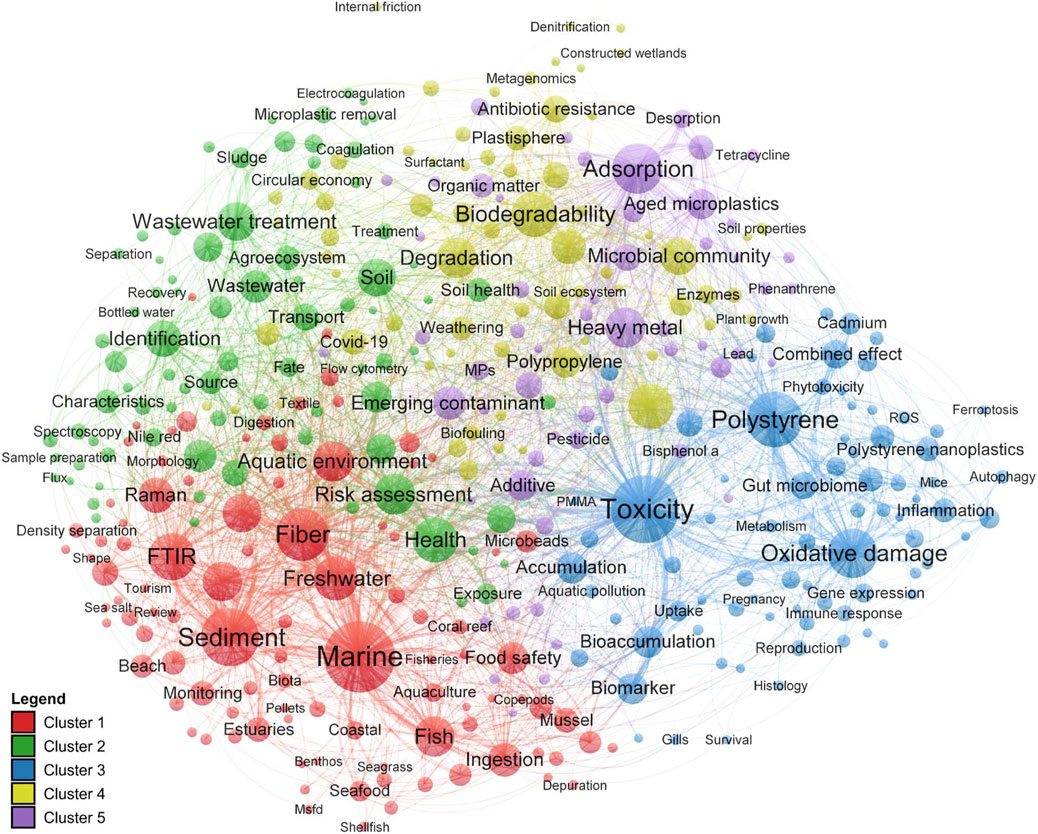
Figure 4. Keywords co-occurrence network of global MPs research. Clusters 1 to 5 correspond to marine MP pollution, MP removal strategies, MP bioaccumulation, MP biodegradability, and adsorption of secondary contaminants onto MPs, respectively.
3.6.1 Cluster analysis
The first cluster in global MP research focuses on the sampling, analysis, and consequences of marine MP pollution. The emergence of this cluster as the largest hub of MP research is partly explained by the fact that the term “microplastic” was first coined with a focus on marine pollution (Thompson et al., 2004). This cluster primarily focuses on the prevalence of MPs in coastal and marine regions, including estuaries and beach sediment studies. Various analytical methods, such as FTIR, Raman Spectroscopy, and SEM imaging, have been involved in the initial studies in marine research, creating a focal point within this cluster on the characteristics of MP particles. Results showed a major focus on fibrous MP and plastic microbeads in marine water and beach sediments. Another area covered by studies in this cluster focuses on identifying MP particles in marine biota, with keywords such as “ingestion,” “gastrointestinal tract,” “fish,” “bivalve,” “mussel,” “shrimps,” and other types of marine organisms. A subsequent focus of this cluster has been the potential impact of seafood MP pollution on human health, with keywords such as “food safety” and “trophic transfer.” According to Figure 5, similar efforts in the Gulf region (cluster 1) reveal that some key elements of marine MP pollution, such as the potential impact on human health, remain to be investigated by new studies in the region. Due to the lack of studies on MP pollution in the Gulf region, one focal point of global cluster 1 emerges as a separate research cluster (cluster 2) in the Gulf region research, focusing on characterizing MPs using similar analytical techniques.
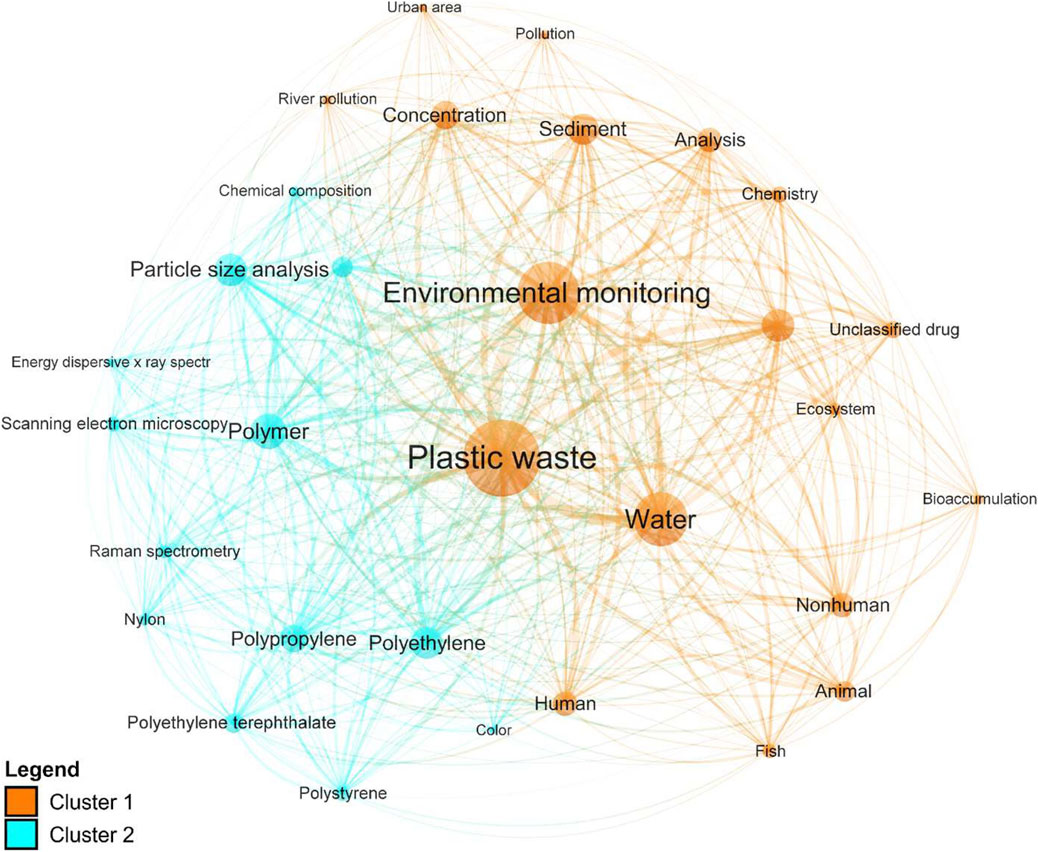
Figure 5. Keywords co-occurrence network of MP research in the Gulf region. Cluster 1 highlights efforts on sampling, analysis, and the consequences of marine MP pollution, with limited exploration of human health impacts. Cluster 2 focuses on characterizing MPs using advanced analytical techniques, reflecting a regional emphasis on foundational aspects of MP research.
The second cluster of global MP research primarily focuses on mitigation and removal strategies for MPs from water and wastewater. Keywords such as “wastewater,” “wastewater treatment,” “water quality,” and “water treatment,” along with treatment methods like “coagulation” and “electrocoagulation,” highlight the efforts to explore “microplastic removal” from these environments. However, the second cluster also includes the distinct topic of atmospheric deposition of MPs, which has a different objective. Additionally, some studies within this cluster investigate the health impacts of indoor and outdoor MPs, indicated by keywords like “inhalation,” “health,” and “exposure.” Compared to other topics, research on MP atmospheric deposition has not expanded as significantly, presenting opportunities for new studies to enhance understanding of the atmospheric mechanisms of MP transport. Examining MP research patterns in the Gulf region (Figure 5) reveals that this specific area remains largely unexplored, with the exception of one effort by Abbasi et al. (2024). Cluster 3 of global MP research predominantly centers on the bioaccumulation and toxicity of MPs in various aquatic and terrestrial organisms. A major theme is exploring how MPs accumulate in the bodies of organisms and their resulting toxicological impacts, encompassing a wide range of biological and cellular effects. Studies frequently investigate oxidative damage and stress mechanisms, apoptosis, autophagy, inflammation, and immune responses, shedding light on the molecular pathways affected by MP exposure. Species-specific research is prevalent, with model organisms such as algae, Daphnia magna, zebrafish, and Caenorhabditis elegans playing pivotal roles in toxicity testing and understanding species-specific responses. The combined effects of MPs with other pollutants and stressors are also a significant focus, highlighting the complexity of environmental exposures. Advanced molecular techniques, including proteomics, transcriptomics, and metabolomics, are extensively employed to elucidate the mechanistic underpinnings of MP toxicity, providing a detailed understanding of changes in gene expression, protein synthesis, and metabolic processes. Overall, this cluster underscores a comprehensive and multifaceted approach to studying the intricate and far-reaching impacts of MPs on biological systems.
Cluster 4 of global MP research centers on the biodegradability and environmental impact of MPs, emphasizing their degradation processes and interactions with microbial communities. Studies focus on how different types of plastics, including polyethylene, polypropylene, and biodegradable alternatives like PLA, break down under various environmental conditions (Gewert et al., 2015; Kole et al., 2017). The role of microbial biofilms and communities in enhancing or inhibiting the degradation process is also a key area of investigation (Galloway and Lewis, 2016). Additionally, research addresses the broader environmental and health implications of MPs, including their potential to carry antibiotic-resistant genes and pathogens (Wright et al., 2020). This cluster also highlights the importance of sustainable management practices, such as recycling and promoting a circular economy, to mitigate plastic pollution (Rochman et al., 2019). Overall, this cluster underscores the need for comprehensive strategies to address the persistence and ecological impacts of MPs.
Cluster 5 centers on the adsorption properties of MPs and their role as vectors for various environmental contaminants, including heavy metals, pharmaceuticals, antibiotics, and persistent organic pollutants. Studies demonstrate that the physicochemical properties of MPs, such as hydrophobicity and surface characteristics, significantly influence their capacity to adsorb these substances, impacting their bioaccessibility and environmental fate (Wang et al., 2019). Environmental factors like salinity, pH, and temperature further affect the adsorption-desorption processes, altering the interactions between MPs and contaminants (Bakir et al., 2016). Research also highlights the changing interaction properties of aged MPs due to weathering, which can modify their adsorption behavior and ecological impact (Holmes et al., 2014). This cluster underscores the complexity of MP pollution, emphasizing the need for comprehensive risk assessments to understand their dual role as pollutants and carriers of hazardous substances (Yu et al., 2021). Comparison between research clusters in global and Gulf region studies reveals that of the five global topical zones, only the first cluster has been explored to a limited extent in the Gulf region, with significant gaps in other zones that require further investigation.
3.6.2 Trending topics analysis
An essential feature of VOSviewer is its overlay analysis, which allows researchers to highlight specific attributes within a bibliometric map, such as citation impact, publication year, or research topics (van Eck and Waltman, 2010). This overlay analysis provides a clear and intuitive way to identify temporal patterns of research through close examination of the emergence year of certain research keywords. The benefits of this feature include the ability to easily identify trends, emerging topics, and influential research within a field (Cobo et al., 2011). Overlay analysis of global and Gulf region studies facilitates trend comparison and identifies topics spearheading future MP research.
Supplementary Figure S1 and Table 4 highlight the temporal evolution of research keywords and the top 20 recent research keywords on both global and Gulf region studies, respectively, providing a detailed comparative view of global and Gulf region trends. Globally, recent keywords such as “Ferroptosis,” “Lettuce,” “Photoaging,” and “Spatiotemporal distribution” have emerged in 2023, reflecting a shift towards novel research areas. In 2022, keywords like “Pregnancy,” “Nitrous oxide,” “ROS,” and “Soil microplastics,” marked an expansion into environmental and health-related impacts. These emerging themes are distributed across multiple clusters, illustrating the breadth of novel research avenues being explored.
In the Gulf region, the latest research keywords from 2022, such as “Energy dispersive X-Ray spectroscopy,” “Ecosystem,” “River pollution,” and “Raman spectrometry,” highlight a focus on analytical techniques and environmental impacts. These recent topics indicate an emerging interest in understanding the analytical and ecological aspects of MP pollution. In contrast, the keywords from 2021, including “Polymer,” “Scanning electron microscopy,” “Pollution,” “Chemical composition,” and “Polypropylene,” reflect an earlier stage of research primarily centered on material types, pollution measurement, and fundamental analytical methods. This temporal progression from 2021 to 2022 underscores a shift from basic material characterization and pollution metrics to more sophisticated analytical techniques and ecosystem impact assessments. The concentration of keywords in clusters 1 and 2 further suggests a focused research agenda in the Gulf region, emphasizing foundational and analytical studies in MP research. These contrasting emergence patterns highlight the maturity and diversification of global MP research, in stark contrast to the Gulf region, where efforts remain in their developmental stages. This disparity underscores the critical need for targeted research initiatives to bridge the gap and foster a more comprehensive understanding of MP pollution in the Gulf region (Supplementary Figure S1).
4 Conclusion
The bibliometric analysis conducted on MP research on both global and Gulf region scales provides a comprehensive overview of the current state and evolution of the field. Globally, the vast array of studies highlights a robust and exponentially growing interest in MPs, evidenced by a significant surge in publications, especially post-2014, peaking in 2023. This global surge highlights a widespread recognition of the environmental and health implications posed by MPs, with a substantial body of research focusing on various aspects ranging from particle size and toxicity to broader environmental impacts. In contrast, MP research in the Gulf region, though increasing, accounts for just 1.1% of the global output, highlighting its underrepresentation. This disparity points to a critical research gap in the region despite its unique environmental challenges and reliance on marine ecosystems. Gulf region studies have shown a growing trend but on a much smaller scale, indicating a nascent but gradually acknowledging field within the local scientific community. Peaks in publications and citations within the Gulf region indicate periods of heightened research activity and interest, likely driven by regional environmental policies or growing scientific capabilities.
Moreover, the analysis of leading journals, authors, and countries further portrays the landscape of MP research. Globally, countries like China dominate the field, contributing significantly through a large number of studies and extensive international collaborations, reflecting their industrial and environmental challenges as well as their scientific ambitions. Conversely, the research in the Gulf region is predominantly led by Iran, highlighting a focused but limited regional effort to address MPs pollution, with much room for growth in terms of both scope and depth.
This study not only identifies the significant research gap present in the Gulf region but also interprets the varying scales of engagement and focus on MP research. The insights drawn highlight the necessity for increased regional research efforts, particularly in understanding the localized impacts of MPs on the marine-rich environments of the Gulf. There is a pressing need for targeted research initiatives to integrate the Gulf region into the global MP studies, fostering more effective local and global environmental health strategies.
Data availability statement
The data that support the findings of this study are openly available at the Federated Research Data Repository (FRDR) website at https://doi.org/10.20383/103.01145
Author contributions
AS: Conceptualization, Data curation, Formal Analysis, Investigation, Methodology, Software, Visualization, Writing–original draft, Writing–review and editing. MM: Conceptualization, Data curation, Formal Analysis, Investigation, Methodology, Software, Visualization, Writing–original draft, Writing–review and editing. MM: Conceptualization, Funding acquisition, Project administration, Resources, Supervision, Writing–review and editing. FR: Conceptualization, Funding acquisition, Project administration, Resources, Supervision, Writing–review and editing.
Funding
The author(s) declare that financial support was received for the research, authorship, and/or publication of this article. We acknowledge funding from the Natural Sciences and Engineering Research Council of Canada (NSERC) Alliance grant “Plastics science for a cleaner future” program to the project “Microplastics Fingerprinting at the watershed scale: from sources to receivers” (Grant No: ALLRP 558435–20).
Acknowledgments
The authors acknowledge the careful and responsible use of Grammarly (www.grammarly.com) to assist in improving the language clarity. All text was thoroughly reviewed and verified to ensure accuracy and adherence to academic standards. The authors assume full responsibility for the content and any errors.
Conflict of interest
The authors declare that the research was conducted in the absence of any commercial or financial relationships that could be construed as a potential conflict of interest.
The author(s) declared that they were an editorial board member of Frontiers, at the time of submission. This had no impact on the peer review process and the final decision.
Publisher’s note
All claims expressed in this article are solely those of the authors and do not necessarily represent those of their affiliated organizations, or those of the publisher, the editors and the reviewers. Any product that may be evaluated in this article, or claim that may be made by its manufacturer, is not guaranteed or endorsed by the publisher.
Supplementary material
The Supplementary Material for this article can be found online at: https://www.frontiersin.org/articles/10.3389/fenvs.2024.1474125/full#supplementary-material
References
Abbasi, S., Ahmadi, F., Khodabakhshloo, N., Pourmahmood, H., Esfandiari, A., Mokhtarzadeh, Z., et al. (2024). Atmospheric deposition of microplastics in Shiraz, Iran. Atmos. Pollut. Res. 15, 101977. doi:10.1016/j.apr.2023.101977
Alfaro-Núñez, A., Astorga, D., Cáceres-Farías, L., Bastidas, L., Soto Villegas, C., Macay, K., et al. (2021). Microplastic pollution in seawater and marine organisms across the tropical eastern pacific and galápagos. Sci. Rep. 11, 6424. doi:10.1038/s41598-021-85939-3
Bakir, A., O’Connor, I. A., Rowland, S. J., Hendriks, A. J., and Thompson, R. C. (2016). Relative importance of microplastics as a pathway for the transfer of hydrophobic organic chemicals to marine life. Environ. Pollut. 219, 56–65. doi:10.1016/j.envpol.2016.09.046
Bäuerlein, P. S., Erich, M. W., van Loon, W. M. G. M., Mintenig, S. M., and Koelmans, A. A. (2023). A monitoring and data analysis method for microplastics in marine sediments. Mar. Environ. Res. 183, 105804. doi:10.1016/j.marenvres.2022.105804
Bornmann, L., and Daniel, H. (2008). What do citation counts measure? A review of studies on citing behavior. J. Doc. 64, 45–80. doi:10.1108/00220410810844150
Cobo, M. J., López-Herrera, A. G., Herrera-Viedma, E., and Herrera, F. (2011). Science mapping software tools: review, analysis, and cooperative study among tools. J. Am. Soc. Inf. Sci. Technol. 62, 1382–1402. doi:10.1002/asi.21525
Cole, M., Lindeque, P., Halsband, C., and Galloway, T. S. (2011). Microplastics as contaminants in the marine environment: a review. Mar. Pollut. Bull. 62, 2588–2597. doi:10.1016/j.marpolbul.2011.09.025
Ellegaard, O., and Wallin, J. A. (2015). The bibliometric analysis of scholarly production: how great is the impact? Scientometrics 105, 1809–1831. doi:10.1007/s11192-015-1645-z
European Commission (2019). “A circular economy for plastics,” in Insights from research and innovation to inform policy and funding decisions. Editors M. De Smet, and M. Linder (Bruxelles, Belgium: Publications Office). doi:10.2777/269031
Everaert, G., Van Cauwenberghe, L., De Rijcke, M., Koelmans, A. A., Mees, J., Vandegehuchte, M., et al. (2018). Risk assessment of microplastics in the ocean: modelling approach and first conclusions. Environ. Pollut. 242, 1930–1938. doi:10.1016/j.envpol.2018.07.069
Fürst, K., and Feng, Y. (2022). China’s regulatory respond to plastic pollution: trends and trajectories. Front. Mar. Sci. 9. doi:10.3389/fmars.2022.982546
Galloway, T. S., and Lewis, C. N. (2016). Marine microplastics spell big problems for future generations. Proc. Natl. Acad. Sci. 113, 2331–2333. doi:10.1073/pnas.1600715113
Gewert, B., Plassmann, M. M., and MacLeod, M. (2015). Pathways for degradation of plastic polymers floating in the marine environment. Environ. Sci. Process. Impacts 17, 1513–1521. doi:10.1039/C5EM00207A
Harris, P. T. (2020). The fate of microplastic in marine sedimentary environments: a review and synthesis. Mar. Pollut. Bull. 158, 111398. doi:10.1016/j.marpolbul.2020.111398
He, L., Ou, Z., Fan, J., Zeng, B., and Guan, W. (2022). Research on the non-point source pollution of microplastics. Front. Chem. 10, 956547. doi:10.3389/fchem.2022.956547
Holmes, L. A., Turner, A., and Thompson, R. C. (2014). Interactions between trace metals and plastic production pellets under estuarine conditions. Mar. Chem. 167, 25–32. doi:10.1016/j.marchem.2014.06.001
Horton, A. A., and Barnes, D. K. A. (2020). Microplastic pollution in a rapidly changing world: implications for remote and vulnerable marine ecosystems. Sci. Total Environ. 738, 140349. doi:10.1016/j.scitotenv.2020.140349
Ibrahim, H. D., Xue, P., and Eltahir, E. A. B. (2020). Multiple salinity equilibria and resilience of Persian/Arabian Gulf basin salinity to brine discharge. Front. Mar. Sci. 7. doi:10.3389/fmars.2020.00573
Ivar do Sul, J. A., and Costa, M. F. (2014). The present and future of microplastic pollution in the marine environment. Environ. Pollut. 185, 352–364. doi:10.1016/j.envpol.2013.10.036
Jiang, T., Wang, M., Zhang, W., Zhu, C., and Wang, F. (2024). A comprehensive analysis of agricultural non-point source pollution in China: current status, risk assessment and management strategies. Sustainability 16, 2515. doi:10.3390/su16062515
Kibria, G. (2023). Impacts of microplastic on fisheries and seafood security — global analysis and synthesis. Sci. Total Environ. 904, 166652. doi:10.1016/j.scitotenv.2023.166652
Koelmans, A. A., Mohamed Nor, N. H., Hermsen, E., Kooi, M., Mintenig, S. M., and De France, J. (2019). Microplastics in freshwaters and drinking water: critical review and assessment of data quality. Water Res. 155, 410–422. doi:10.1016/j.watres.2019.02.054
Kole, P. J., Löhr, A. J., Van Belleghem, F., and Ragas, A. (2017). Wear and tear of tyres: a stealthy source of microplastics in the environment. Int. J. Environ. Res. Public Health 14, 1265. doi:10.3390/ijerph14101265
Li, J., Liu, H., and Paul Chen, J. (2018). Microplastics in freshwater systems: a review on occurrence, environmental effects, and methods for microplastics detection. Water Res. 137, 362–374. doi:10.1016/j.watres.2017.12.056
Liu, J., Yang, Y., An, L., Liu, Q., and Ding, J. (2022). The value of China’s legislation on plastic pollution prevention in 2020. Bull. Environ. Contam. Toxicol. 108, 601–608. doi:10.1007/s00128-021-03366-6
Lusher, A. L., Hurley, R., Arp, H. P. H., Booth, A. M., Bråte, I. L. N., Gabrielsen, G. W., et al. (2021). Moving forward in microplastic research: a Norwegian perspective. Environ. Int. 157, 106794. doi:10.1016/j.envint.2021.106794
Meyers, N., Kopke, K., Buhhalko, N., Mattsson, K., Janssen, C. R., Everaert, G., et al. (2024). Value for money: a cost-effectiveness analysis of microplastic analytics in seawater. Microplastics Nanoplastics 4, 4. doi:10.1186/s43591-024-00081-x
Phan, S., and Luscombe, C. K. (2023). Recent trends in marine microplastic modeling and machine learning tools: potential for long-term microplastic monitoring. J. Appl. Phys. 133. doi:10.1063/5.0126358
Prata, J. C., Silva, A. L. P., da Costa, J. P., Mouneyrac, C., Walker, T. R., Duarte, A. C., et al. (2019). Solutions and integrated strategies for the control and mitigation of plastic and microplastic pollution. Int. J. Environ. Res. Public Health 16, 2411. doi:10.3390/ijerph16132411
Razeghi, N., Hamidian, A. H., Wu, C., Zhang, Y., and Yang, M. (2021). Microplastic sampling techniques in freshwaters and sediments: a review. Environ. Chem. Lett. 19, 4225–4252. doi:10.1007/s10311-021-01227-6
Rochman, C. M., Brookson, C., Bikker, J., Djuric, N., Earn, A., Bucci, K., et al. (2019). Rethinking microplastics as a diverse contaminant suite. Environ. Toxicol. Chem. 38, 703–711. doi:10.1002/etc.4371
Samimi-Namin, K., and Hoeksema, B. W. (2023). Hidden depths: a unique biodiversity oasis in the Persian Gulf in need of further exploration and conservation. Diversity 15, 779–788. doi:10.3390/d15060779
Stöfen-O′Brien, A., Naji, A., Brooks, A. L., Jambeck, J. R., and Khan, F. R. (2022). Marine plastic debris in the Arabian/Persian Gulf: challenges, opportunities and recommendations from a transdisciplinary perspective. Mar. Policy 136, 104909. doi:10.1016/j.marpol.2021.104909
Tan, Y., Dai, J., Wu, X., Wu, S., and Zhang, J. (2022). Characteristics, occurrence and fate of non-point source microplastic pollution in aquatic environments. J. Clean. Prod. 341, 130766. doi:10.1016/j.jclepro.2022.130766
Tang, K. H. D., and Hadibarata, T. (2021). Microplastics removal through water treatment plants: its feasibility, efficiency, future prospects and enhancement by proper waste management. Environ. Challenges 5, 100264. doi:10.1016/j.envc.2021.100264
Thompson, R. C., Olsen, Y., Mitchell, R. P., Davis, A., Rowland, S. J., John, A. W. G., et al. (2004). Lost at sea: where is all the plastic? Science 304, 838. doi:10.1126/science.1094559
Thompson, R. C., Swan, S. H., Moore, C. J., and vom Saal, F. S. (2009). Our plastic age. Philos. Trans. R. Soc. B Biol. Sci. 364, 1973–1976. doi:10.1098/rstb.2009.0054
Thushari, G. G. N., and Senevirathna, J. D. M. (2020). Plastic pollution in the marine environment. Heliyon 6, e04709. doi:10.1016/j.heliyon.2020.e04709
van Eck, N. J., and Waltman, L. (2010). Software survey: VOSviewer, a computer program for bibliometric mapping. Scientometrics 84, 523–538. doi:10.1007/s11192-009-0146-3
Wang, J., Liu, X., Li, Y., Powell, T., Wang, X., Wang, G., et al. (2019). Microplastics as contaminants in the soil environment: a mini-review. Sci. Total Environ. 691, 848–857. doi:10.1016/j.scitotenv.2019.07.209
Wang, J., and Shapira, P. (2011). Funding acknowledgement analysis: an enhanced tool to investigate research sponsorship impacts: the case of nanotechnology. Scientometrics 87, 563–586. doi:10.1007/s11192-011-0362-5
Wright, S. L., Ulke, J., Font, A., Chan, K. L. A., and Kelly, F. J. (2020). Atmospheric microplastic deposition in an urban environment and an evaluation of transport. Environ. Int. 136, 105411. doi:10.1016/j.envint.2019.105411
Xu, Y., Chan, F. K. S., He, J., Johnson, M., Gibbins, C., Kay, P., et al. (2021). A critical review of microplastic pollution in urban freshwater environments and legislative progress in China: recommendations and insights. Crit. Rev. Environ. Sci. Technol. 51, 2637–2680. doi:10.1080/10643389.2020.1801308
Keywords: microplastic, Gulf region, bibliometric analysis, cluster analysis, marine pollution
Citation: Shabib A, Reshadi MAM, Maraqa MA and Rezanezhad F (2024) Microplastic research trends in the Gulf region from a global perspective. Front. Environ. Sci. 12:1474125. doi: 10.3389/fenvs.2024.1474125
Received: 01 August 2024; Accepted: 25 November 2024;
Published: 11 December 2024.
Edited by:
Pengfei Wu, Nanjing Forestry University, ChinaReviewed by:
Nitin Agarwala, Centre for Joint Warfare Studies, IndiaBhuvan Vemuri, Micron, United States
Shen Tingting, Taizhou University, China
Copyright © 2024 Shabib, Reshadi, Maraqa and Rezanezhad. This is an open-access article distributed under the terms of the Creative Commons Attribution License (CC BY). The use, distribution or reproduction in other forums is permitted, provided the original author(s) and the copyright owner(s) are credited and that the original publication in this journal is cited, in accordance with accepted academic practice. No use, distribution or reproduction is permitted which does not comply with these terms.
*Correspondence: Mir Amir Mohammad Reshadi, YW0ucmVzaGFkaUB1d2F0ZXJsb28uY2E=
†These authors have contributed equally to this work
 Ahmad Shabib
Ahmad Shabib Mir Amir Mohammad Reshadi
Mir Amir Mohammad Reshadi Munjed A. Maraqa
Munjed A. Maraqa Fereidoun Rezanezhad
Fereidoun Rezanezhad